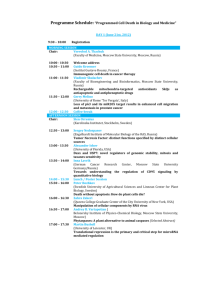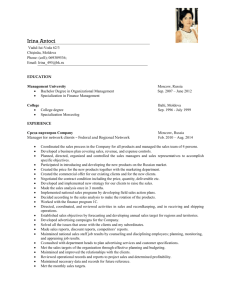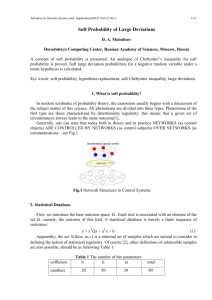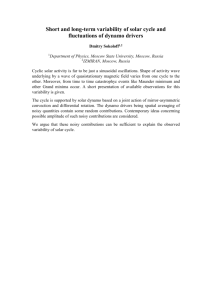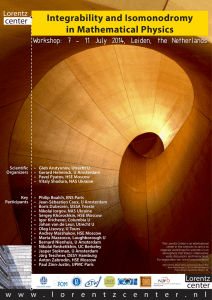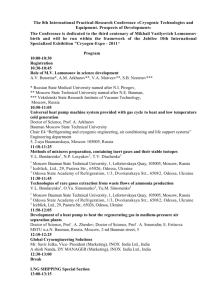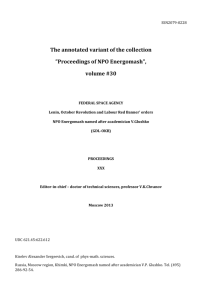The example of paper
advertisement
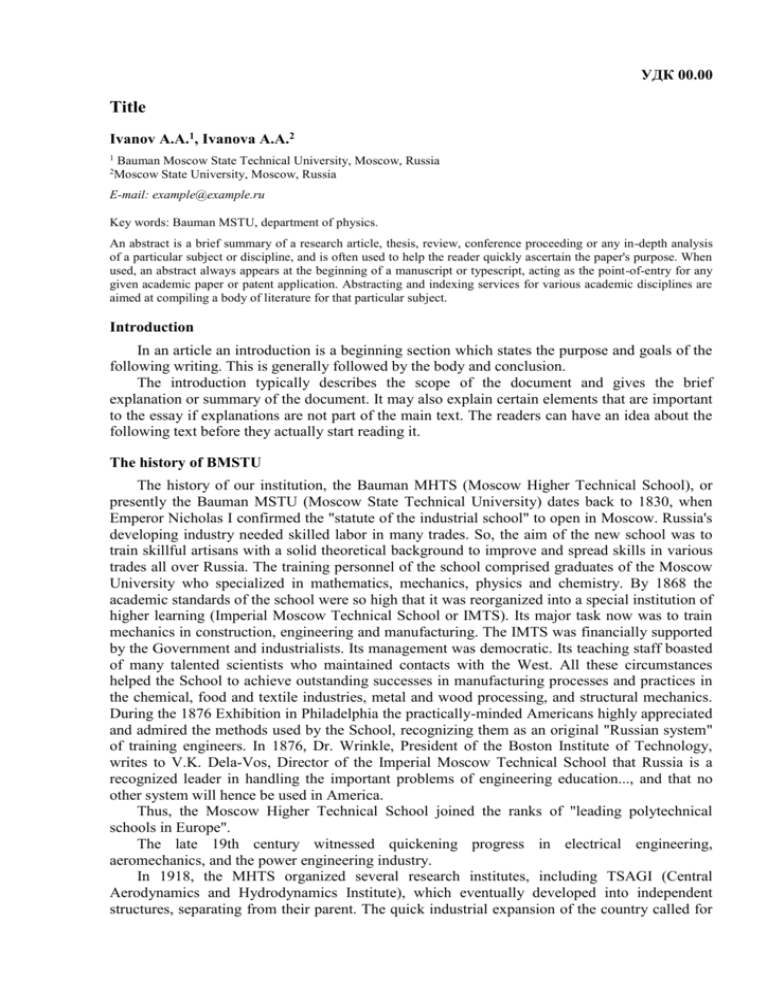
УДК 00.00 Title Ivanov A.A.1, Ivanova A.A.2 1 2 Bauman Moscow State Technical University, Moscow, Russia Moscow State University, Moscow, Russia E-mail: example@example.ru Key words: Bauman MSTU, department of physics. An abstract is a brief summary of a research article, thesis, review, conference proceeding or any in-depth analysis of a particular subject or discipline, and is often used to help the reader quickly ascertain the paper's purpose. When used, an abstract always appears at the beginning of a manuscript or typescript, acting as the point-of-entry for any given academic paper or patent application. Abstracting and indexing services for various academic disciplines are aimed at compiling a body of literature for that particular subject. Introduction In an article an introduction is a beginning section which states the purpose and goals of the following writing. This is generally followed by the body and conclusion. The introduction typically describes the scope of the document and gives the brief explanation or summary of the document. It may also explain certain elements that are important to the essay if explanations are not part of the main text. The readers can have an idea about the following text before they actually start reading it. The history of BMSTU The history of our institution, the Bauman MHTS (Moscow Higher Technical School), or presently the Bauman MSTU (Moscow State Technical University) dates back to 1830, when Emperor Nicholas I confirmed the "statute of the industrial school" to open in Moscow. Russia's developing industry needed skilled labor in many trades. So, the aim of the new school was to train skillful artisans with a solid theoretical background to improve and spread skills in various trades all over Russia. The training personnel of the school comprised graduates of the Moscow University who specialized in mathematics, mechanics, physics and chemistry. By 1868 the academic standards of the school were so high that it was reorganized into a special institution of higher learning (Imperial Moscow Technical School or IMTS). Its major task now was to train mechanics in construction, engineering and manufacturing. The IMTS was financially supported by the Government and industrialists. Its management was democratic. Its teaching staff boasted of many talented scientists who maintained contacts with the West. All these circumstances helped the School to achieve outstanding successes in manufacturing processes and practices in the chemical, food and textile industries, metal and wood processing, and structural mechanics. During the 1876 Exhibition in Philadelphia the practically-minded Americans highly appreciated and admired the methods used by the School, recognizing them as an original "Russian system" of training engineers. In 1876, Dr. Wrinkle, President of the Boston Institute of Technology, writes to V.K. Dela-Vos, Director of the Imperial Moscow Technical School that Russia is a recognized leader in handling the important problems of engineering education..., and that no other system will hence be used in America. Thus, the Moscow Higher Technical School joined the ranks of "leading polytechnical schools in Europe". The late 19th century witnessed quickening progress in electrical engineering, aeromechanics, and the power engineering industry. In 1918, the MHTS organized several research institutes, including TSAGI (Central Aerodynamics and Hydrodynamics Institute), which eventually developed into independent structures, separating from their parent. The quick industrial expansion of the country called for new training facilities on other fields of science and technology. In 1930, the MHTS began to branch out into many new institutions of higher learning: the Moscow Aviation Institute, the Moscow Power Engineering Institute, the Military Chemical Academy, the Textile Institute, and the Moscow Civil Engineering Institute. The MHTS continued to specialize in training engineers for the machine-building and instrumentation industries. In 1938, the MHTS opened new departments with a defense profile: armoured vehicles and tanks, artillery, and ammunition. In 1948, a department of rocketry was added. The following famous scientists and specialists have graduated our school: Academician A.N. Tupolev, S.P. Korolev, and many other aircraft and rocket designers and developers; Academician N.A. Dollezhal, chief designer of atomic piles; Academician A.I. Tselikov, chief designer of metallurgical engineering; Academician S.A. Lebedev, chief designer of computers. Our School is distinguished for high-level scientific and engineering training of students, extensive relations with industries, good traditions, and high professional and moral requirements which both the professors and students feel obliged to meet and maintain. In 1989, the MHTS was conferred a new name: the Bauman Moscow State Technical University (Bauman MSTU). Department of Physics Department of Physics of Bauman Moscow State Technical University (BMSTU) has worked since 1832, when Physical Study to demonstrate physical phenomena during lectures for students was created at the Craft Institution of Moscow Training House. On the first June in 1968 the Craft Institution was reformed into Emperor Moscow Technical Specialized School and the Physical Study got a new official status as Department of General and Applied Physics. Professor A.S. Vladimirskii, who had graduated from Moscow University, headed the Department. The brightest historical moments of the Department were linked with names of professor V.S. Shchegolyaev (the head of the Department since 1886 till 1912) and academician P.P. Lazarev (the head of the Department since 1912 till 1925). At different times a number of remarkable scientists have worked at the Department: academician, president of USSR Science Academy S.I. Vavilov, corresponding-members of USSR Science Academy K.A. Krug and A.S. Predvoditelev, professors A.B. Mlodzievskii, A.K. Trapeznikov, A.V. Shpol'skii, N.E. Uspenskii, V.D. Zernov, K.A. Putilov. At present the staff of the Department of Physics consists of 14 professors, 47 readers, 8 senior teachers and 7 professors, 15 readers, 7 senior teachers occupy private positions. The main scientific directions of the Department of Physics are Electro-hydrodynamics; Theory of strength and destruction for solid bodies; Process theory of non-linear transference; Electrodynamics of moving media; Optics and spectroscopy; Applied electrodynamics and radio-physics ; Nonreversible process research in natural media. Theory of precise measurements; Theory of interference phenomena in electrodynamics and solid state physics; Physics of magnetic materials; Quantum optics; There is a laboratory for student researching at the Department of Physics. Since 2001 the Department of Physics trains on the courses of bachelor and master degrees in Engineering Physics. Conclusion A Conclusion is an ending section which states the concluding ideas and concepts of the preceding writing. References 1. Martin J. Crowder. Multivariate Survival Analysis and Competing Risks // Chapman and Hall. 2012. 417 p. 2. May S., Hosmer D.W. A simplified method of calculating an overall goodness-of-fit test for the Cox proportional hazards model // Lifetime Data Anal. 1998. Vol. 4. P. 109-120. Participants from Russia must also complete the following information in Russian language: Заголовок Иванов A.A.1, Иванова A.A.2 1 2 МГТУ им. Н.Э. Баумана, Москва, Россия МГУ, Москва, Россия E-mail: example@example.ru Ключевые слова: МГТУ им. Н.Э. Баумана, кафедра физики. Аннотация должна включать в себя: предмет и цель работы (если они не следуют из названия статьи), используемый метод или методы исследования, основные результаты исследования, отличия данной публикации от других, схожих по теме, область применения результатов, выводы, рекомендации, перспективы развития работы.

